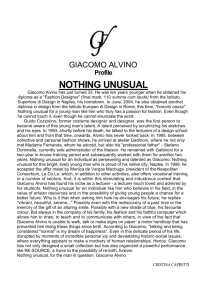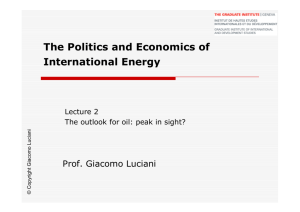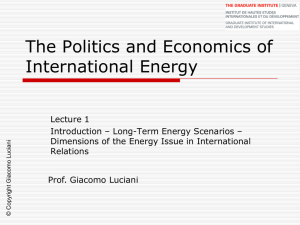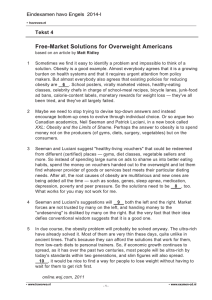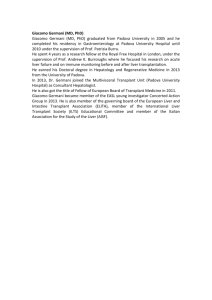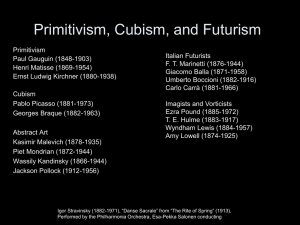Lecture_05 - Graduate Institute of International and
advertisement
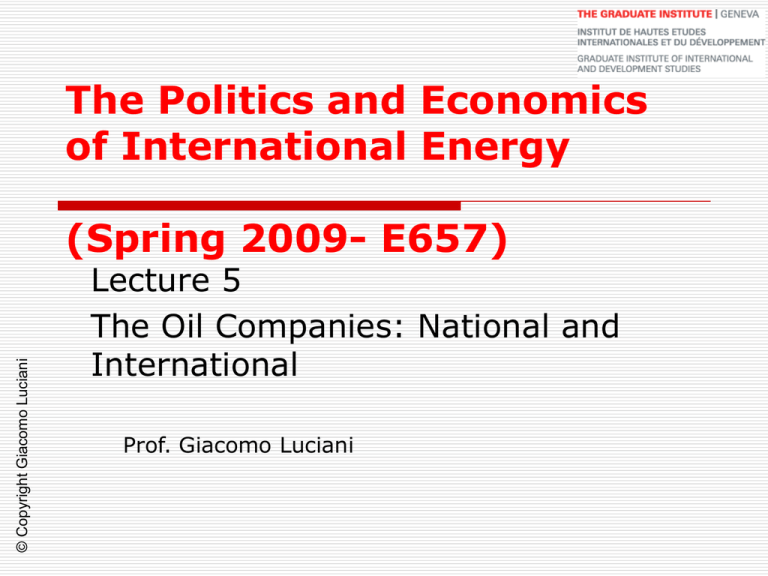
The Politics and Economics of International Energy © Copyright Giacomo Luciani (Spring 2009- E657) Lecture 5 The Oil Companies: National and International Prof. Giacomo Luciani © Copyright Giacomo Luciani What are Oil Companies? Companies are the main protagonists in the international oil and gas industry Companies are living organisms that take time to develop and grow, acquire a specific know-how and develop their own culture Companies are different – main cleavage between IOCs and NOCs, but certainly not the only important distinction 2 © Copyright Giacomo Luciani The Oil Industry The system of companies constitutes the organisation of the industry Key issues: vertical integration and horizontal concentration The industry has gone through several waves of integration/disintegration, and concentration/fragmentation 3 © Copyright Giacomo Luciani Vertical integration Vertical integration is a consequence of the presence of a “strategic segment” If markets do not work properly companies controlling the strategic segment have an opportunity and incentive to integrate upstream/downstream in the value chain Doubts about the benefits of vertical integration 4 © Copyright Giacomo Luciani Horizontal concentration Historically, oil and gas have been abundant, conditions for “excessive” competition have existed Large up front investment encourages high capacity utilisation even in negative market conditions Periodic waves of financial difficulty lead to disappearance of companies through mergers and acquisitions 5 © Copyright Giacomo Luciani Beginnings in the USA Law of capture: low barriers to entry. Booms and busts: the rigidity of oil supply and demand in the short term Rockefeller and the strategic importance of pipelines and refining The Standard Oil Trust Spindletop and the Texas Railroad Commission 6 © Copyright Giacomo Luciani Outside the USA More limited demand, competition from town gas Developments in Russia and the Far East Initial developments in the Ottoman Empire Initial interest in Persia 7 © Copyright Giacomo Luciani The coming of Gulf Oil D’arcy and Churchill: the birth of Anglo-Persian as a political object The negotiations for IPC The Red Line Agreement The Great Depression and the Achnacarry agreement Result: slow down the development of Gulf oil 8 © Copyright Giacomo Luciani Further Developments in the Gulf Kuwait and British-American relations Bahrain and Saudi Arabia: the US and the formation of ARAMCO The golden age of the Seven Sisters The Iranian crisis and the formation of the Iranian consortium Newcomers: Libya, independents, NOCs 9 Equity participation in the main producing companies before 1972 © Copyright Giacomo Luciani Kuwait Oil Company (KOC) Royal Dutch - Shell Standard Oil New Jersey Standard Oil California Texaco Mobil British Petroleum Gulf CFP Altri Iraq Petroleum Company (IPC) 23,750 11,875 50 50 100 11,875 23,750 Arabian Abu Dhabi Iranian American Marine Consortium Company Areas (Aramco) (ADMA) 30 30 30 10 23,750 5,000 100 66,66 33,33 100 100 14 7 7 7 7 40 7 6 5 100 10 Companies change names © Copyright Giacomo Luciani Standard Oil Company Standard Oil New Jersey Standard Oil New York Standard Oil Indiana Standard Oil Ohio Standard Oil California ESSO Mobil Amoco Sohio Chevron EXXONMOBIL Anglo-Persian Anglo-Iranian British Petroleum BP 11 © Copyright Giacomo Luciani Middle East Oil is Underexploited This has been the case from the beginning, and a cause of considerable conflict The international oil industry has consistently had to deal with the threat of oversupply and price collapse Reserve additions do not come in small increments and supply is rigid in the short term 12 © Copyright Giacomo Luciani Oil Companies Control Vertical integration Joint Production companies based on agreements aiming at maintaining production under control Contract typology: concession Very large concession territory Blatant asymmetry of information 13 Vertical integration - up to 1970’s © Copyright Giacomo Luciani Companies were present in all stages: exploration production shipping refining retail distribution Balanced presence in all stages was key to profitability An oil market existed, but was neither transparent nor efficient 14 Refining The Eight Majors’ Market Share, 1970 Gulf Mobil 4,6% Exxon 12,4% B P 5,4% CFP 1,9% © Copyright Giacomo Luciani altri Production Socal 4,8% Texaco 8,3% Mobil 5,4% 6,6% Mobil 5,4% 15,7% Exxon Shell 13,0% 49,3% Products Sales Gulf 8,3% Texaco 6,4% Shell 11,9% (in percent) Socal 4,1% Socal 4,1% Shell 13,1% Gulf 4,2% Texaco 7,3% Exxon 14,2% BP 5,4% CFP 2,0% 29,1% BP 10,4% CFP 3,2% 15 altri altri 43,7% © Copyright Giacomo Luciani Conflict and evolution Tax assessment Relinquishment Posted price Nationalization Smaller concessions and multiple operators OPEC 16 © Copyright Giacomo Luciani OPEC - a cartel by chance OPEC was created in 1960, but had little impact for a decade or more because of conflict over production targets. In 1969-73 some countries lost interest in increasing production and imposed unilateral limitations. Prices exploded. 17 © Copyright Giacomo Luciani Nationalisations Early nationalisations: Russia and Mexico Mossadegh nationalises APOC Qaddafi nationalises BP, Hunt Kuwait, Algeria, Qatar, Iraq: 100% nationalisations Abu Dhabi, Libya: IOCs remain Saudi Arabia: negotiated takeover 18 0 2001 1997 1993 1989 1985 1981 1977 1973 1969 1965 1961 1957 1953 1949 1945 1941 1937 1933 1929 1925 1921 1917 1913 '000 b/d © Copyright Giacomo Luciani Historical Production of 4 Main Gulf Producers 12000 10000 8000 6000 Iran Iraq Kuwait S. Arabia 4000 2000 19 Evolution of contractual relations Concession: Company pays royalty and taxes but is in full control of production and marketing Production sharing agreement: © Copyright Giacomo Luciani IOC carries all investment costs; if a commercial find is declared, production is divided: “cost oil” to IOC, “profit oil” shared bet. IOC and NOC Service contract: IOC develops field and gets a fee Iranian contracts: IOC develops field then transfers “operatorship” and gets predetermined volumes of oil 20 © Copyright Giacomo Luciani Concession vs PSA A concession is more likely to lead to conflict because of issues of tax assessment or management of production. A PSA is more easily enforceable but it is very difficult to write a PSA that will be “fair” at any level of oil price. Both can be combined with NOC participation 21 The PSA is versatile © Copyright Giacomo Luciani A PSA is a very versatile contract – it can mean anything, depending on the numbers. Key issues are: How much of early production will be considered as cost oil? What is the split of profit oil? Is it a function of volumes produced and/or oil price? 22 Access to World Proven Oil Reserves end-2005 9 © Copyright Giacomo Luciani 37 National Companies Only Limited access Production sharing Concessions Iraq 30 11 13 Source: IEA 23 © Copyright Giacomo Luciani Fiscal tightening Production sharing contracts which used to be based on simple sliding scales of production at varying thresholds have now in the main been superseded by rate of return based contracts. Such contracts are awarded to the company which offers the lowest rate of return on the concession. This has the merit of effectively capping the reward to the IOC when oil prices are very high and maximising the rent to the host government. The extent to which IOCs are prepared to push down rates of return was highlighted in the recent bidding round in Libya where many companies bid a percentage rate of return of just 7 per cent on a number of blocks, very close to their weighted average cost of capital. Therefore, even in the event of exploration success, it is very unlikely that these companies will add shareholder value from the concessions they were awarded. 24 © Copyright Giacomo Luciani Following 1973… Following 1973, the International Oil Industry was forcibly dis-integrated: the 7/8 sisters lost most of their reserves. Some disappeared fast; other attempted to recreate a vertical equilibrium by divesting downstream and looking for new reserves. Hence came the investment boom in nonOpec countries – but not all were “open”. 25 © Copyright Giacomo Luciani Consequences of disintegration Notwithstanding moves to recreate vertical integration, the industry continues to be disintegrated. NOCs have divergent attitudes towards downstream integration (PDVSA and KOC vs. Aramco) The IOCs concentrate their investment in the upstream. A lot of crude is exchanged at arm’s length 26 © Copyright Giacomo Luciani Oil Market Development Disintegration encouraged oil market development – and vice versa Oil market development changed the concept of security and eroded the rationale for NOCs of the importing countries Privatisation, profit maximisation, shareholders value 27 © Copyright Giacomo Luciani Pressure from financial analysts The financial market has become increasingly demanding Companies have made imprudent promises The M&A logic The opportunistic behavior of shareholders and managers – preference for the short term 28 © Copyright Giacomo Luciani Recent Mergers BP acquired Sohio, Amoco, Arco, Castrol, Veba Oil, TNK Exxon acquired Mobil Chevron acquired Gulf, Texaco, Unocal Total acquired Elf and Fina Phillips acquired Tosco, merged with Conoco Shell acquired Enterprise Eni acquired Lasmo Repsol acquired YPF 29 © Copyright Giacomo Luciani Degree of Established International Portfolio 30 © Copyright Giacomo Luciani Vertical Integration in Doubt The development of crude and other markets raises doubts on the benefits of vertical integration Companies have tended to get out of less profitable/more volatile segments: transport, refining, petrochemicals Investment has been heavily concentrated on the upstream 31 © Copyright Giacomo Luciani Capital Rotation 1990 to 2001 32 © Copyright Giacomo Luciani Persistence of vertical integration Nevertheless vertical integration has persisted Pure upstream companies have not fared very well Independent refiners have also succumbed Pure retailers are rare Service companies have multiplied 33 © Copyright Giacomo Luciani BP - a case study BP is the company that has found the most oil It has also suffered most from nationalisations: Iran, Nigeria, Libya, Kuwait… Discovered Prudhoe Bay in 1968 Discovered Forties in 1970 …just in time to compensate for nationalisations… 34 © Copyright Giacomo Luciani BP and Sohio BP initially acquired a minority interest in Sohio when it decided to associate the latter to the development of Prudhoe Bay Eventually, BP’s interest grew to be a majority in the company Bought out the minority interest in 1987 Enter KIO 35 © Copyright Giacomo Luciani Privatisation problems The British government sold its 31.5% remaining participation in BP in October 1987 The sale was a flop because of negative stock market conditions – KIO bought The MMC found that KIO’s holding could operate against the public interest; a cap of 9.9% was imposed on KIO’s holding BP bought back KIO’s excess shares incurring in a major financial burden. 36 © Copyright Giacomo Luciani 37 © Copyright Giacomo Luciani 38 © Copyright Giacomo Luciani BP Amoco 39 © Copyright Giacomo Luciani 40 Russian industry position 2002 production mboed 1600 1200 800 400 Lukoil Yukos NewCo Surgutneftegaz TNK Sibneft Tatneft Sidanco 0 © Copyright Giacomo Luciani 42 © Copyright Giacomo Luciani 43 © Copyright Giacomo Luciani 44 © Copyright Giacomo Luciani BP and TNK-BP Plan Strategic Alliance with Gazprom as TNK-BP Sells its Stake in Kovykta Gas Field Under the terms of the agreement signed by all parties, TNK-BP agreed to sell Gazprom its 62.89 per cent stake in Rusia Petroleum, the company which holds the licence for the Kovykta gas field in East Siberia. It will also sell its 50 per cent interest in East Siberian Gas Company (ESGCo), the company constructing the regional gasification project. TNK-BP said a longer-term 'call' option for TNK-BP to buy a 25 per cent plus one share stake in Kovykta at an independently verified market price, had also been agreed with Gazprom. This option could be exercised once a significant joint investment or asset swap has been agreed under the terms of today's memorandum of understanding. (June 22, 2007) 45 © Copyright Giacomo Luciani 46 © Copyright Giacomo Luciani The new protagonists The companies of the producing countries – mostly state owned, some privately owned – are the new protagonists of the international oil industry. How many will evolve into major international oil companies? 47 © Copyright Giacomo Luciani The ambiguous IOC/NOC relations IOCs and NOCs are rivals However, they also live in a symbiotic equilibrium Can this dichotomy be progressively overcome? What forms of partnership? 48 The merits of going with IOCs Crude Oil Production in Selected OPEC Countries, 1969-2004 4000 3500 2500 Algeria 2000 Libya Qatar 1500 United Arab Emirates 1000 Venezuela 500 0 1969 1971 1973 1975 1977 1979 1981 1983 1985 1987 1989 1991 1993 1995 1997 1999 2001 2003 1,000 b/d © Copyright Giacomo Luciani 3000 49 © Copyright Giacomo Luciani 50 A rush to open? © Copyright Giacomo Luciani In the 1990s the impression was created that resource nationalism was obsolete However: Some expected openings never materialised (Kuwait, Iraq, partially Russia) Other were disappointing (Brazil, China, Azerbaijan) Key players never considered opening (Saudi Arabia, Mexico) 51 © Copyright Giacomo Luciani The return of nationalism Resource nationalism is back alive and kicking Venezuela changed strategy entirely under Chavez Russia is increasingly pursuing a nationalist agenda in oil and gas Iraq will not open indiscriminately and remains a distant prospect 52 © Copyright Giacomo Luciani What is wrong with IOCs? In the eyes of producing countries, IOCs are dangerous if they are not needed In the new price climate, IOCs profits seem excessive, countries feel cheated There is divergence of views on optimal drawdown of reserves: Companies maximize short-term profit Governments want “sufficient” revenue for as long as possible 53 © Copyright Giacomo Luciani 54 © Copyright Giacomo Luciani 55 © Copyright Giacomo Luciani 56 © Copyright Giacomo Luciani 57 © Copyright Giacomo Luciani 58 © Copyright Giacomo Luciani 59 © Copyright Giacomo Luciani 60 © Copyright Giacomo Luciani 61 © Copyright Giacomo Luciani 62 © Copyright Giacomo Luciani 63 © Copyright Giacomo Luciani 64 © Copyright Giacomo Luciani 65 © Copyright Giacomo Luciani 66 © Copyright Giacomo Luciani 67 © Copyright Giacomo Luciani 68 © Copyright Giacomo Luciani 69 © Copyright Giacomo Luciani 70
